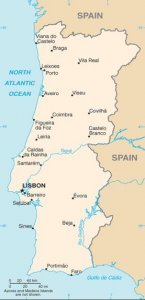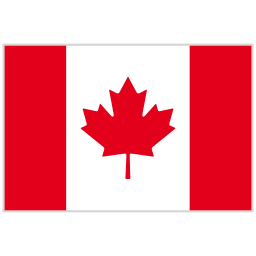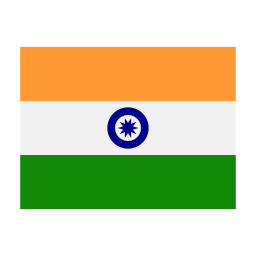PORTUGAL – GENERAL INFORMATION

GEOGRAPHY
The territory of Portugal includes an area in the Iberian Peninsula referred to as the continent by most Portuguese) and two archipelagos in the Atlantic Ocean: the archipelagos of Madeira and the Azores. Mainland Portugal is split by its main river, the Tagus that flows from Spain and disgorges in Tagus Estuary, in Lisbon, before escaping into the Atlantic. The northern landscape is mountainous towards the interior with several plateaus indented by river valleys, whereas the south, that includes the Algarve and the Alentejo regions, is characterized by rolling plains. Portugal’s Exclusive Economic Zone, a sea zone over which the Portuguese have special rights over the exploration and use of marine resources, has 1,727,408 km2. This is the 3rd largest Exclusive Economic Zone of the European Union and the 11th largest in the world.
HISTORY

A European and an Atlantic nation, dates back to the Early Middle Ages. In the 15th and 16th centuries, it ascended to the status of a world power during Europe’s “Age of Discovery” as it built up a vast empire including possessions in South America, Africa, Asia and Australasia. In the next two centuries, Portugal kept most of its colonies but gradually lost much of its wealth and status as the Dutch, English and French took an increasing share of the spice and slave trades (the economic basis of its empire), by surrounding or conquering the widely scattered Portuguese trading posts and territories, leaving it with ever fewer resources to defend its overseas interests.
Signs of military decline began with two disastrous battles: the Battle of Alcácer Quibir in Morocco in 1578 and Spain’s abortive attempt to conquer England in 1588 – Portugal was then in a dynastic union with Spain, and contributed ships to the Spanish invasion fleet. The country was further weakened by the destruction of much of its capital city in a 1755 earthquake, occupation during the Napoleonic Wars and the loss of its largest colony, Brazil, in 1822. From the middle of the 19th century to the late 1950s, nearly two-million Portuguese left Europe to live in Brazil and the United States (U.S.).
In 1910, there was a revolution that deposed the monarchy. Amid corruption, repression of the church, and the near bankruptcy of the state, a military coup in 1926 installed a dictatorship that remained until another coup in 1974. The new government instituted sweeping democratic reforms and granted independence to all of Portugal’s African colonies in 1975.
Portugal is a founding member of the North Atlantic Treaty Organization (NATO), the Organisation for Economic Co-operation and Development (OECD), and the European Free Trade Association (EFTA). It entered the European Community (now the European Union) in 1986.
THE PEOPLE
The Portuguese (Portuguese: os portugueses) are a Western Romance nation and ethnic group native to the country of Portugal, in the west of the Iberian Peninsula of Southwestern Europe. Their language is Portuguese, and Roman Catholicism is the predominant religion.
Historically, the Portuguese descend from the Pre-Celts who inhabited the Iberian Peninsula with the Lusitanians forming the manifold identity of the country, followed by the Romans. Other major segments include the Suebi, the Visigoths and the Gallaeci.
Due to the large historical extent of the Portuguese Empire and the colonization of territories in Asia, Africa and the Americas, as well as historical and recent emigration, Portuguese communities can be found in many diverse regions around the globe, and a large Portuguese diaspora exists.
SOCIAL CONVENTIONS
The pace of life is leisurely and normal courtesies should be observed. Each district has its own folklore and traditions. Smoking is prohibited in doors. When meeting and greeting in Portugal Initial greetings are reserved, yet polite and gracious. The handshake accompanied by direct eye contact and the appropriate greeting for the time of day. Once a personal relationship has developed, greetings become more personal: men may greet each other with a hug and a handshake and women kiss each other twice on the cheek starting with the right.
LANGUAGES
The official language of Portugal is Portuguese. Portuguese is today one of the world’s major languages, ranked 6th according to number of native speakers (approximately 240 million). English is compulsory language in high school. In urban areas the knowledge of English is widespread. In more rural areas, the number of speakers will decrease.
GOVERNMENT
The Government comprises the Prime Minister, vice-prime ministers, ministers, secretaries of State (junior ministers) and under-secretaries of State. Each minister usually heads a ministry and has assigned to him or her one or more secretaries of state.
TIME ZONE
GMT + 1.
ELECTRICITY
220 volts AC, 50Hz, with continental 2pin plugs.
CLIMATE
Portugal is one of the warmest European countries. In mainland Portugal, yearly temperature averages are about 15°C (55°F) in the north and 18°C (64°F) in the south. Madeira and Azores have a narrower temperature range as expected given their insularity, with the former having low precipitation in most of the archipelago and the latter being wet and rainy. Spring and Summer months are usually sunny and temperature maximum are very high during July and August, with maximums averaging between 35°C and 40°C (86°F – 95°F) in the interior of the country, 30°C and 35°C in the north. Autumn and Winter are typically rainy and windy, yet sunny days are not rare either. Temperatures rarely fall below 5°C (41°F) nearer to the sea, averaging 10°C (50°F), but can reach several degrees below 0°C (32°F) further inland. Snow is common in winter in the mountainous areas of the north, especially in Serra da Estrela but melts quickly once the season is over. Portugal’s climate can be classified as Mediterranean (particularly the southern parts of the Algarve and Alentejo, though technically on Atlantic shore).
Clothes to Wear:
The north of Portugal has a maritime climate, cool and often wet. The southern and inland regions are more continental with a warm drier climate. Temperatures can be very high here in mid-summer. Lisbon is generally mild and sunny but rain can be expected throughout the year. Portugal is usually warm from April to October – medium weight clothing is recommended and rainwear. Casual wear is acceptable; however, beachwear should be restricted to the beach and pool areas.
LOGISTICAL
Entry & Exit Requirements:
Portugal is a party to the Schengen Agreement. As such, U.S. citizens for business or tourism are permitted to stay in the Schengen area for 90 days without a visa within a six-month period. The passport should be valid for at least three months beyond the period of stay. Visas are not needed by U.S., Canadian, Irish, Australian, New Zealand, or British citizens for visits of less than 3 months.
For updated visa information, contact the Embassy of Portugal in Washington, DC or the Portuguese Consulates in Boston, MA; New Bedford, MA; Providence, RI; New York, NY; Newark, NJ; or San Francisco, CA. The Embassy of Portugal is located at 2012 Massachusetts Avenue NW, Washington, DC 20036, tel. (202) 350-5400. Visit the Government of Portugal’s website for the most current contact information for Portuguese embassies and consulates.
Embassy Locations:
US Embassy in Lisbon
American Citizen Services
U.S. Embassy Lisbon
Av. das Forças Armadas, Sete-Rios
1600-081 Lisbon, Portugal
Telephone: 351 21 770-2122
Emergency after-hours telephone: 351-21-770-2122 or 351 21 727-3300
Facsimile: 351 21 727-2354
Canadian Embassy in Portugal
Avenida da Liberdade, 198-200, 3rd Floor1269-121LisbonPortugal
Tel.:21-316-4600
Fax:21-316-4693
E-mail: lsbon@international.gc.ca
Health:
Information on vaccinations and other health precautions, such as safe food and water precautions and insect bite protection, may be obtained from the Centers for Disease Control and Prevention’s (CDC) hotline for international travelers at 1-800-CDC-INFO (1-800-232-4636) or via the CDC website at http://wwwnc.cdc.gov/travel. For information about outbreaks of infectious diseases abroad, consult the infectious diseases section of the World Health Organization (WHO) website at http://www.who.int/topics/infectious_ diseases/en/. The WHO website also contains additional health information for travelers, including detailed country-specific health information.
Banks & Currency:
The euro, the new single European currency, became the official currency of Portugal and 11 other countries on January 1, 1999, but not in the form of cash. On January 1, 2002, euro bank notes and coins were introduced. During a 2-month transition period, escudo notes, the old currency of Portugal, were withdrawn from circulation. The symbol of the euro is €; its official abbreviation is EUR.
It’s a good idea to exchange at least some money — just enough to cover airport incidentals and transportation to your hotel — before you leave home (though don’t expect the exchange rate to be ideal), so you can avoid lines at airport ATMs (automated teller machines).
The easiest and best way to get cash away from home is from an ATM, sometimes referred to as a “cash machine,” or a “cashpoint.” Banks are open 8.30am – 3.00pm Monday to Friday in Portugal and closed on official holidays. Foreign currencies and especially Travellers cheques are now a day’s difficult to exchange in banks (unless depositing) just like travellers cheques in specialized stores called Foreign Exchange Bureaus in Portugal. You should consider purchasing the Euro currency at a more favorable exchange rate, at home before you arrive in Portugal. Most major credit cards are widely accepted and recommended but consult with your credit or debit card bank about the foreign exchange transaction fees charged for using your card in Portugal.Note: Many banks impose a fee every time you use a card at another bank’s ATM, and that fee can be higher for international transactions (up to $5 or more) than for domestic ones (where they’re rarely more than $2). In addition, the bank from which you withdraw cash may charge its own fee. For international withdrawal fees, ask your bank.
Communication:
IDD services are available and the outgoing international code is 00. International calls can be made from public phones found in many towns and most villages. Public phones may also be found in cafes and bars, at more of a cost. The eKit access number for Portugal is: 800-812-993.
ENTERTAINMENT
Food and Drink:
It is safe to drink tap water in all of Portugal, being effectively disinfected. Some irregular situations are found in small rural communities. Bottled water is widely available for the more sensitive stomachs. Portuguese cuisine is closely related to Mediterranean cuisine. The influence of Portugal’s former colonial possessions is also notable, especially in the wide variety of spices used. These spices include piri piri (small, fiery chilli peppers) and black pepper, as well as cinnamon, vanilla and saffron. Olive oil is one of the bases of Portuguese cuisine both for cooking and flavouring meals. Garlic is widely used, as are herbs such as coriander and parsley. Portuguese breakfasts often consist of fresh bread, with butter, ham, cheese or fruit preserves, accompanied with coffee, milk, coffee with milk, tea or hot chocolate. Sweet pastries are also very popular, as well as breakfast cereal, mixed with milk or yogurt and fruit. Lunch, often lasting over an hour is served between noon and 2 o’clock or between 1 and 3 o’clock, and dinner is generally served late, around or after 8 o’clock. There are three main courses, lunch and dinner usually include soup. A common soup is caldo verde with potato, shredded kale, and chunks of chouriço sausage. Among fish recipes, salt cod (bacalhau) dishes are pervasive. The most typical desserts are rice pudding (decorated with cinnamon) and caramel custard. There is also a wide variety of cheeses made from cow, sheep or goat’s milk or even mixture of different kinds of milk. The most famous are queijo da serra from the region of Serra da Estrela, São Jorge cheese from the Portuguese island of São Jorge, and Requeijão. A popular pastry is the pastel de nata, a small custard tart often sprinkled with cinnamon.
Nightlife:
There are plenty of nightclubs, bars, cafés and cinemas in Portugal.
Sunset does not mean it’s the end of the day (especially on a weekend or a typical summer night). For many, the day is just beginning and many bars haven’t even opened their doors yet. If clubbing isn’t your scene, classical music is well represented at various venues, as well as elegant restaurants, and major concert venues.
Shopping:
Here’s a list of some of the more enchanting artifacts and handicrafts produced in Portugal:





BAGGAGE
Baggage rules for international and domestic air travel have changed much in recent years, differ from carrier to carrier and these days even may cover your on-board bags. Checking luggage may cost a separate fee or may be free depending on your personal status with the carrier. We therefore encourage you to read your ticket’s small print and/or contact your carrier for exact rules.
TIPPING
Tipping in restaurants is optional. Waiters earn wages in Portugal and a ‘tip’ is considered a note of appreciation, not a means to make up for a tiny salary – if you are not too happy with the service, don’t tip. Keep in mind that whilst tipping, most people in Portugal would just round up the total bill to the next euro. Even in expensive restaurants more than 2 to 3 euro would be hardly justified. Tipping taxi drivers and daily tips for hotel staff are not customary in Portugal.
LAUNDRY
Limited.
PHOTOS & VIDEOS
In some countries you must refrain from photographing sites such as Military bases and industrial installations. Also be aware of cultural sensitivities when taking pictures of or near churches and other religious sites. It is always courteous to ask for permission before taking photographs of people.
USE OF DRONES
The use of drones is being legislated by many countries. In some cases drones are already forbidden and their unauthorized use may carry severe penalties. If you plan to travel with a drone please contact the embassy or consulate of the country you wish to visit.




